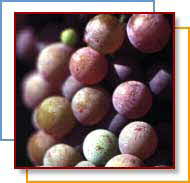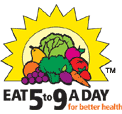Home | FOOD ARTICLES | Food Trivia | Today_in_Food_History | Food_History_Timeline | Recipes | Cooking_Tips | Food_Videos | Food_Quotes | Who’s_Who | Culinary_Schools_&_Tours | Food_Trivia_Quizzes | Food_Poems | Free_Magazines | Food_Festivals_and_Events
Food Articles, News & Features Section
FREE Magazines
and other Publications
Free Professional and Technical Research, White Papers, Case Studies, Magazines, and eBooks
GRAPES
See also: Grape Trivia; Grape Quotes
The grape is one of the oldest fruits to be cultivated going back as far as biblical times. Spanish explorers introduced the fruit to America approximately 300 years ago. Some of the most popular ways in which the fruit is used, is eaten fresh, in preserves or canned in jellies, dried into raisins, and crushed for juice or wine. Although, machines have taken the place of much handwork, table grapes are still harvested by hand in many places.
(Wellness Encyclopedia of Food and Nutrition, 1992).
Grapes are about 80 percent water, making them a delectable low-calorie snack or dessert; a cup of Concord or Catawba grapes contains only about 60 calories Grapes also add fiber to the diet and are naturally low in sodium. Raisins, or dried grapes, contain only about 15 percent water. For this reason, nutrients and calories are more concentrated in raisins-one cup contains 464 calories! Like other dried fruit, raisins are a good source of iron. Serving Size 1-1/2 cups (138g/14.9oz)

Varieties
Grapes come in more than 50 varieties in black, blue, blue-black, golden, red, green, purple, and white colors with a juicy pulp inside. The two main types of grapes are the American and European. They both come in seeded and seedless varieties. Common varieties include Thompson, Flame, Ruby, Perlette and Tokay grapes. Most U.S. grapes are grown in California.
Selecting Grapes
Look for firm, plump, well-colored clusters of grapes that are securely attached to their green stems. Fully ripe grapes are soft and tender. Grapes showing signs of decay, shriveling, stickiness, brown spots or dry brittle stems should be avoided. Blue Concord grapes are excellent for table use and for making juice and jelly. The large, purplish-red catawba variety is used primarily for making juice and wine, but can also be served fresh for eating.
Using and Preserving Grapes
Fresh Facts
- Fresh grapes maintain good quality for two to three days in the refrigerator. Store in a covered container or plastic bag.
- Just before use, wash grape clusters under a gentle spray of water, drain and pat dry.
Table grapes are at their best served slightly chilled to enhance their crisp texture and refreshing flavor.
- Seedless grapes are used whole. For seeded grapes, remove seeds by cutting grapes into halves lengthwise and scooping out seeds with the point of a knife.
- Grapes are easier to peel when they're frozen. Just rinse frozen grapes in lukewarm water until skins split. Skins will then slip right off.
- When preparing small clusters of grapes for garnishing, cut the clusters with scissors. This helps keep the grapes attached to the stem.
- For longer storage, grapes can be canned, frozen or made into juice or sweet spreads to enhance meals throughout the year. Grapes can be dried as raisins for use as a snack or in baking.
Canned Facts
• Seedless grapes can be canned whole for use in fruit salads and molded gelatin desserts. If seeded varieties are used, halve and remove seeds before canning.
• Grape juice can be canned both sweetened and unsweetened. If juice will be made into jelly later, it's best to can it without sugar-then add the proper amount of sugar at jelly making time.
• To prevent mold growth, seal grape jelly with two-piece canning lids and process for five minutes in a simmering water bath.
Freezer Facts
• Frozen grape juice is of excellent quality—serve it alone or mixed with other juices. Freeze a few grape "popsicles" for an icy summer treat.
• Freeze grape puree for use in making grape pie and to flavor yogurt.
• Tray freeze seedless grapes and store them in freezer containers. When summer temperatures sizzle, chill summer drinks with "grape" ice cubes.
• For an easy, refreshing summer dessert, serve tray frozen grapes in a chilled glass bowl.
Dried Facts
• The quality of dried grapes, or raisins, is excellent.
• For best results, use seedless grapes. If seeded varieties are used, remove seeds as described under Fresh Facts before drying.
• In areas of high humidity, sun drying is not recommended. For best results, dry grapes in a dehydrator or oven.
Make Grapes Part of Your 5 A Day Plan
It is easy to include grapes in your 5 A Day Plan. They're the original fast food so pack them before you leave home in your lunch or as a snack. Add grapes to any meal as a side dish, especially chicken. Eat grapes as a midmorning or midday snack. Freeze grapes and eat straight from the freezer.
Quick 'N Fresh Ideas
No time to make a fancy dessert? Serve clusters of chilled grapes on a platter with several types of cheese. Let guests serve themselves.
A breakfast that's guaranteed to wake up slow starters…heap light green honeydew melon halves with luscious red grapes and top with yogurt. A toasted muffin makes this quick meal a nutritious morning starter.
For a delicious one-course summer dinner, add chilled grapes to your favorite pasta, chicken or seafood salad. Serve with crusty bread or roll
RELATED ARTICLES
Please feel free to link to any pages of FoodReference.com from your website.
For permission to use any of this content please E-mail: james@foodreference.com
All contents are copyright © 1990 - 2025 James T. Ehler and www.FoodReference.com unless otherwise noted. All rights reserved.
You may copy and use portions of this website for non-commercial, personal use only.
Any other use of these materials without prior written authorization is not very nice and violates the copyright.
Please take the time to request permission.


